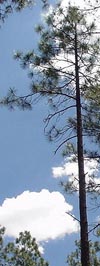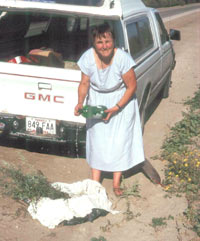|
Biogardener Homepage with links to my other websites
Trees & Shrubs
Edible Garden
Getting Started Organically
Environmental Issues
Meet Traute Klein

Tree Links
Trees Free for the Taking
Willow, the Aspirin Tree, I
Willow, the Aspirin Tree, II
Propagating Water-guzzling Hardwoods
Principles of Tree Pruning

 The above photo shows me preparing trees for transport home after digging them up in a ditch which is legal in Canada.
Amazon BooksTrees of North AmericaGolden Field Guide for easy identification
|
Healing Treesby Traute Klein, biogardener
Trees of Life According to the book of Genesis, the first book in the Bible, the "Tree of Life" stands in the middle of the Garden of Eden, also called Paradise. According to the Book of Revelation, the last book in the Bible, its leaves provide healing to the nations. Every environmental conference I have ever heard of has focused on the South American rainforest and how to save it from further destruction. My first webpage, linked in the lest column of this page, was built in the GeoCities neighborhood called "Rainforest," and it certainly was a popular one. The term rainforest has become synonymous with environment, recycling, and organic gardening. The webmasters of the GeoCities Rainforest sites were telling the world that looking after our own little paradise is just as vital to our own health and the health of this world as worrying about the South American rainforest. All plants are sources of life to this world, but trees hold a special place, if for no other reason than for their enormous size. It takes a lot of small plants to produce the same amount of chlorophyll and oxygen as one single tree. Trees for Healing When the white man settled the North American prairies, he found them well suited to grasslands. As a result, the original "bush," as prairie forests are called, was decimated to make way for expansive wheat fields. The center of the continent became the breadbasket of the world. In many areas of the prairies, none of the original vegetation remains. On my 20 acres of Manitoba prairie, I have been trying to recreate the kind Garden of Eden which Nature had intended for it. I have a little stand of the original bush left. The trees there are poplars and hawthorn, and wildflowers grow in their shade. I do not know of any medicinal benefits of poplars. Certainly they provide chlorophyll and oxygen which are building blocks of life. Hawthorn, however, is one of the best-known medicinal shrubs. Its leaves are indeed healing to the nations. The flowers and fruit share the same qualities. Recreating Paradise To stop the drain of nutrients from my piece of prairie and to undo the effect of years of herbicide and synthetic fertilizers, I stopped the growing of wheat cold turkey. If I had to do it over again, I would try to get seeds of native grasses and wildflowers to establish a natural prairie meadow. Well, I did the next best thing to it. I had alfalfa hay seeded, but I rarely have the hay cut. Leaving it on the land helps to trap snow in the winter, and that snow protects the trees from the effects of extreme temperature changes. The original poplar stand is expanding. It is gradually creeping into the hayfield by growing its extensive root system which sends up suckers here and there. The hawthorn appears to be spreading through bird droppings which contain seeds, but that procedure is slow. I have tried transplanting hawthorn but have come to the conclusion that it is impossible. Maybe I should try to help the birds in their effort to scatter the seeds. The Folly of Shelterbelts At the rate we are going, it would take a couple of centuries for the existing bush to spread over the entire half mile strip of land. I don't want to wait that long, so I am giving Nature a helping hand by planting trees in other areas of the field. The Canadian government provides us with free seedlings to plant on the land. These come from Indian Head, Saskatchewan. They are to provide the bare land with shelterbelts. These shelterbelts are to prevent further soil erosion by breaking the force of the wind. They also provide shelter to wildlife. While I applaud the idea of shelter belts, I do not approve of the way that people apply it. I see rows and rows of the same tree planted on a field with diverse terrain. In this area where the effects of the ice age are written all over the landscape, the various elements of terrain never come in straight lines. Trees need to be chosen to fit their environment if they are to thrive. I plant willows in the swampy areas of the field. They are happy where their unquenchable thirst can be satisfied, even if they need to stand in water all summer as they did quite often since the 1997 Read River Flood of the Century. I plant needle trees on the highest ground, because they do not take kindly to getting their feet wet during the spring melt. Each tree needs to be matched to its preferred location. I also give my trees interesting and compatible neighbors. Planting a whole stand of a monoculture is a dangerous practice, one which nature abhors. If a disease or pest should strike the species, the whole stand could get wiped out in one year. If there is a little space between trees of the same species, they have a better chance of leading a long healthy life. Healing Trees As much as possible, I introduce trees and shrubs which either bear fruit for wildlife and for me, or those which have medicinal properties. Foremost among those is my very favorite tree, the North American basswood. We Germans call it "Linde," and the British name is "lime." I have written about its medicinal properties in the article "Email from Heaven" which is linked below. It is considered hardy to zone 3. In my zone 2, I am pushing my luck. That is why I make sure that the hay surrounding each tree facilitates a good snow trap. So far, I have lost only 1 out of 4 of the basswood trees which I have planted. It did not survive the first winter.
|
The material on this site may be reproduced or republished only by special arrangement with the webmaster.
You are, however, welcome to pass on or link the URL.